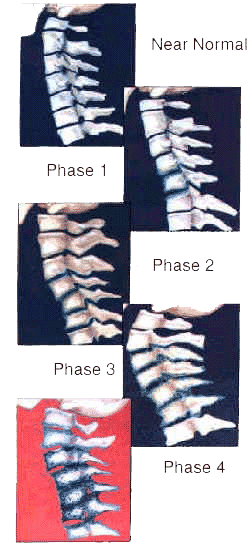Regardless of age, when spinal damage goes uncorrected, the body deposits calcium on the surface of adjacent bones that arenít moving properly.
CHIROPRACTIC CARE CAN HELP PREVENT SUBLUXATION DEGENERATION.
If neglected long enough, this splinting effect can result in complete fusion. This worsening process is called Subluxation Degeneration and can occur throughout the spine. Researchers recognize several phases of spinal decay:
| Degeneration
Phase One (birth to age 20) Usually seen as the misalignment and malfunction of the spine. Normal spinal motion, curves, and disc spacing are altered. Because the body is so adaptable, this early phase can exist without the warning of pain or other symptoms. If left uncorrected, the degeneration continues.
The response to spinal care is generally good. Degeneration
Phase Two (ages 20 to 40)
With Chiropractic, significant improvement is possible. Degeneration
Phase Three (ages 40 to 65)
Some reversal is possible. Degeneration Phase Four (65 and older)
This is often irreversible. Chiropractic care may provide symptomatic relief only. |
|
Chiropractic care can reduce, halt, and even reverse spinal degeneration by improving spinal balance and posture and keeping your joints, nerves, and discs, healthy and strong. Of course, the best approach to spinal degeneration is to prevent it in the first place! That's why spinal check-ups for all children and adults should be a part of everyone's health care regimen.
Spinal degeneration is one of the more obvious effects of spinal nerve stress damage. In North America, significant amounts of spinal degeneration can be detected in over one-third of the population by age 30. By age 70, it is present in nearly everyone and often in advanced stages; it has been blamed for the 198, 000 cases of patients who are either bed or chair ridden.
Conditions
Treated | Subluxation Complex |
Subluxation
Degeneration
Neck | Headache
| Shoulder
| Back | Disc
| Sciatica
Pregnancy | Kids
| Sports


